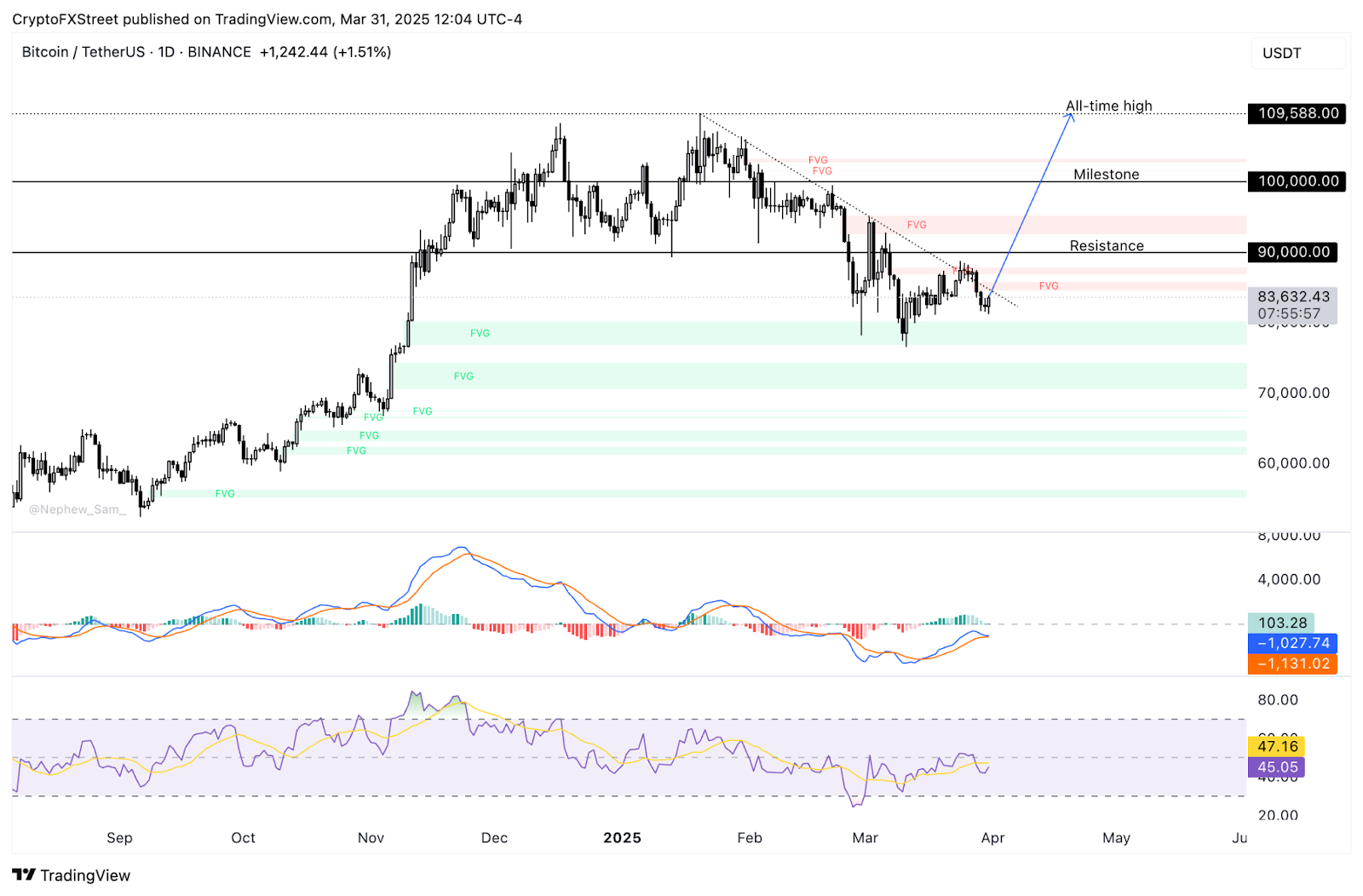- Bitcoin remains above $83,000 after experiencing four days of price decline.
- The total market capitalization of cryptocurrencies fell by nearly 2% in the past 24 hours as traders adopt a cautious stance in anticipation of Trump’s Liberation Day.
- Mining tokens, AI tokens, and meme coins are among the sectors most adversely affected by the market correction.
Bitcoin is trading above $83,000 at the start of Monday, recovering from a four-day downward trend in price. The crypto market cap has decreased to $2.783 trillion, losing almost 2% of its value within the last 24 hours.
As traders prepare for Liberation Day on April 2, several leading cryptocurrencies are experiencing modest gains.
If Bitcoin can regain lost value, it might push against resistance levels at $85,000, with sustained upward momentum potentially establishing a V-shaped recovery for the asset.
Crypto traders brace for Trump’s Liberation Day
The upcoming Liberation Day on April 2 promises to usher in a new wave of tariffs, including added duties on several countries. This policy will affect 15 of the US’s major trading partners.
In response to Trump’s measures, various nations have threatened retaliation. Traders are processing this information and watching for potential volatility in risk assets.
The state of liquidations in the derivatives market reflects this sentiment. The crypto sector recorded over $327 billion in liquidations over the past 24 hours, and the Fear & Greed Index indicates that traders remain apprehensive, much like they did last week and month.
Crypto Fear & Greed Index | Source: Alternative.me
In the last 24 hours, Bitcoin, Ethereum (ETH), Binance Coin (BNB), and Solana (SOL) have experienced slight recoveries.
Is a V-shaped recovery on the horizon for Bitcoin?
Bitcoin is rapidly approaching the $85,000 resistance level. The leading cryptocurrency might test the $90,000 threshold before attempting to revisit the $100,000 landmark and re-testing its all-time high of $109,588.
If Bitcoin maintains its upward trend, it could achieve a V-shaped recovery in the coming weeks. This requires BTC to stay strong and close daily candlesticks above significant resistance points, converting them into support levels on the daily price chart.
Two key momentum indicators, the Relative Strength Index (RSI) and Moving Average Convergence Divergence (MACD), support a bullish outlook for Bitcoin. The RSI is at 45 and trending upwards, while the MACD shows green histogram bars above the neutral line.

BTC/USDT daily price chart | Source: TradingView
While there is market uncertainty leading up to Liberation Day, traders are anticipating a response similar to those seen following previous tariff announcements. Bitcoin has bounced back from four sudden crashes since the 2024 election results, suggesting the asset could recover again after a decline.
These sectors are struggling as traders adopt a conservative approach
Among various crypto token categories, Artificial Intelligence (AI), meme coins, and mining tokens appear to be the most adversely affected as of Monday. Tokens from decentralized exchanges and those within the Bittensor ecosystem have experienced declines between 3% and 5% over the last day.
Crypto category performance | Source: CoinGecko
Expert insights from Dan Greer, co-founder of DeFi App
Dan Greer, co-founder of DeFi App, shared his perspectives on the recent decisions regarding crypto and executive orders associated with the Trump administration.
Q. What are your views on the Trump administration’s plan for the Strategic Crypto Reserve?
The Strategic Crypto Reserve represents a significant initiative. If managed properly, it could transform the global financial landscape. I foresee the administration framing this reserve as both a monetary safeguard and a geopolitical instrument that enhances the US Dollar’s relevance in the digital age while countering rivals that are developing parallel financial systems. If conducted transparently and with genuine digital asset exposure like Bitcoin, it may expedite institutional adoption, normalize crypto within sovereign portfolios, and create benchmarks for how governments interact with decentralized technologies.
Q. Do you anticipate Bitcoin purchases by the US government, or will they likely adhere to the original strategy?
With Trump’s communications and increasing institutional agreement on Bitcoin’s importance, I believe some level of Bitcoin accumulation is likely. The reserve may initially contain crypto-backed instruments or ETF exposure, but actual BTC purchases would signal a genuine commitment to long-term investment. However, I wouldn’t be shocked if the administration opts for a phased strategy, beginning with custodial exposure through private partnerships, then gradually transitioning to on-chain reserves as legislation and custody frameworks advance.
Q. What is your assessment of the Trump administration’s influence on crypto in the early months of his return to office?
The tone has shifted significantly from a hostile regulatory stance to a focus on strategic positioning. The Trump administration is prioritizing crypto as an integral aspect of US financial policy rather than an afterthought. With the initiation of the Strategic Crypto Reserve, support for stablecoin legislation, and clearer guidance around digital asset policies, we are witnessing the policy alignment that has been absent for years. Nevertheless, successful implementation is crucial. Even in the first 90 days, the market has reacted with newfound optimism, resulting in increased capital flows and clearer regulatory direction.
Q. What are your top three predictions for crypto in the first half of 2025, particularly regarding the progress of crypto-related bills in Congress, executive orders, and the Strategic Crypto Reserve?
Stablecoin legislation will pass. There’s a bipartisan interest and surging adoption, leading the US to regulate stablecoins as digital currency. Expect executive orders aimed at digital asset infrastructure, which will expedite updates to custody, taxation, and reporting standards—clearing the path for more institutional engagement. We will likely see initial steps toward the crypto reserve, whether through public ETF exposures, strategic collaborations, or direct on-chain ventures.
